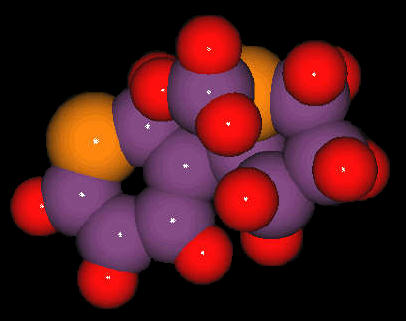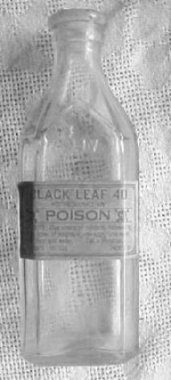
I was surprised to learn that all nicotine comes from the tobacco plant, including nicotine in nicotine replacement products such as the patch, gum, and lozenge.
Although the creation of synthetic nicotine is possible (neonicotinoids), imagine the regulatory hoops that the industry would need to jump through in order to be allowed to market synthetic nicotine for human consumption.
Instead, the pharmaceutical industry competes with the tobacco industry in purchasing tobacco from tobacco farmers and extracting nicotine from it.
Nicotine is a colorless, odorless, liquid organic-based alkaloid in the same family as cocaine, morphine, quinine, and strychnine. It slowly yellows when exposed to air, is bitter-tasting, and gives off a slightly fishy odor when warmed.[1]
When holding dry tobacco in your hand, the weight of nicotine within it will vary depending upon the type of tobacco. While nicotine's weight averages about 3% in cigarettes[2] and moist snuff, it comprises 1.6% of a tobacco plug's weight and about 1% of the weight of chewing tobacco.[3]
One of the most toxic of all poisons,[4] nicotine is a fetal teratogen that damages the developing brain.[5] A natural insecticide formed in the roots of the tobacco plant, it helps protect the plant's roots, stalk, and leaves from being eaten by insects and animals.
Nicotine was originally sold as an alkaloid insecticide in America under the brand name Black Leaf 40, a mixture that was 40% nicotine sulfate.[6] The use of similar nicotine products continues to be touted in organic gardening as a means for killing insects.

Neonicotinoids are synthetic forms of the natural insecticide nicotine, and possibly the most widely used insecticides worldwide.
Sold under brand names such as Imidacloprid and Thiamethoxam (TMX), neonicotinoids attach to the insect's acetylcholine receptors. The insect then exhibits leg tremors, rapid wing motion, and disoriented movement followed by paralysis and death.
There is growing concern that widespread use of neonicotinoids may be responsible for killing bees and colony collapse disorder.[7]
How deadly is nicotine? It's nearly twice as deadly as black widow spider venom (.5 mg/kg versus .9mg/kg) and at least three times deadlier than diamondback rattlesnake venom (.5 mg/kg versus 1.9mg/kg).
LD50 is an abbreviation for the lethal dose of a toxic chemical. It represents the amount of the chemical needed to kill 50% of humans weighing 160 pounds. Although based upon animal studies and increasingly disputed, nicotine's generally recognized minimum adult LD50 is 30mg (milligrams), and if ingested in liquid form death may occur within 5 minutes.[8]
Drop for drop, that makes nicotine as deadly as strychnine, which also has a minimum adult LD50 of 30mg,[9] and more deadly than arsenic (50mg)[10] or cyanide (50mg).[11]
Nicotine kills by eventually paralyzing breathing muscles. Prior to death, symptoms include salivation, nausea, vomiting, abdominal pain, diarrhea, dizziness, weakness, and confusion progressing to convulsions, hypertension and coma.[12]
Although the average American cigarette contains 8 to 9 milligrams of nicotine,[13] some is burned, some escapes through cigarette ventilation, and the filter traps some. The lungs absorb nearly 90% of inhaled nicotine.[14]
It results in the average smoker introducing 1.17 to 1.37 milligrams of nicotine into their bloodstream with each cigarette smoked.[15] Average intake can vary significantly from smoker to smoker, ranging from 0.3 to 3.2 mg of nicotine per cigarette.[16]
Picture the largest rat you have ever seen. It would weigh about a pound. The 1mg of nicotine that entered your bloodstream from your last nicotine fix would be sufficient to kill that rat.

A smoker smoking 30 cigarettes per day is, over an entire day, bringing enough nicotine into their body to have killed a 160-pound human, if the entire 30 milligrams had arrived all at once. Two to three drops of nicotine in the palm of the hand of someone weighing 160 pounds or less and he or she is dead.
E-cigarette nicotine juice is seemingly everywhere. It makes you wonder why we haven't seen substantially more poisoning news. While animal studies may not be as applicable to humans as once thought, keep in mind that the debate is over how much nicotine it takes to kill someone.
With liquid nicotine, the body's overdose response (nausea and vomiting) may also be playing a factor in helping rid the body of enough to avoid disaster.
Those pushing a growing array of nicotine products often assert that they are as safe as caffeine. Far from it.
At least in animal studies, nicotine is at least 166 times more toxic than caffeine. Caffeine's lethal dose is 10 grams or 10,000 milligrams, compared to 30 milligrams for nicotine.
Picture a substance more toxic than rattlesnake or black widow venom being fed to your brain day after day after day. Is it any wonder that a 2004 study using brain MRI imaging found that "smokers had smaller gray matter volumes and lower gray matter densities than nonsmokers?"[17]
Contrary to findings from studies examining the short-term (acute) effects of nicotine,[18] studies of the long-term (chronic) effects of smoking nicotine report decline and impairment of attention, concentration, and the accuracy of working and verbal memory.[19]
Visualize nicotine's neurotoxic effects upon the human brain slowly destroying it,[20] while damaging what remains.[21] Possibly the most frightening of all the risks posed by our addiction is its ability to destroy all memory of why we need to stop.
As for those selling a growing array of nicotine products, their marketing ploys and the research backing their sales pitch will always micro-focus upon the effects of just a few of the more than 200 neurochemicals that nicotine controls (usually the stimulants), while ignoring the big picture.
Their goal is to make money by selling us nicotine, not to free us from requiring it. Their marketing will never value the loss of personal freedom to a never-ending need to feed, nor discuss in a fair and honest manner the harms inflicted by nicotine upon those addicted to it.
Do you know of any alcoholic rehabilitation program that recommends switching from whiskey to pure alcohol, and then trying to slowly wean yourself off over a period of 90 days?
Who benefits from such a treatment method when it takes just 3 days to rid the body of all nicotine and move beyond peak withdrawal?
References:
2. Blakely T et al, New Zealand Public Health Report on Nicotine, May 27, 1997.
3. Tilashalski, K et al, Assessing the Nicotine Content of Smokeless Tobacco Products, Journal of the American Dental Association, May 1994, Volume 125, Pages 590-594.
4. de Landoni, JH, Nicotine, IPCS INCHEM, March 1991.
5. Roy TS, et al, Nicotine evokes cell death in embryonic rat brain during neurulation, The Journal of Pharmacology and Experimental Therapeutics, December 1998, Volume 287(3), Pages 1136-1144.
6. Cornell University, nicotine (Black Leaf 40) Chemical Profile, Pesticide Management Education Program (PMEP), April 1985.
7. Whitehorn PR, et al, Neonicotinoid pesticide reduces bumble bee colony growth and queen production, Science, April 20, 2012, Volume 336(6079), Pages 351-352.
8. Cornell University, Nicotine (Black Leaf 40) Chemical Profile, April 1985.
9. Borges, A et al, Strychnine (PIM 507), March 1989, IPSC INCHEM.
10. Benedetti, JL, Arsenic (PIM G042), July 1996, IPSC INCHEM.
11. van Heijst, ANP, Cyanides (PIM G003), February 1988, IPSC.
12. de Landoni, JH, Nicotine (PIM 373), March 1991, IPCS INCHEM.
13. Benowitz NL, et al, Establishing a nicotine threshold for addiction. The implications for tobacco regulation, New England Journal of Medicine, July 14, 1994, Volume 331(2), Pages 123-125.
14. Philip Morris, Memorandum, Media Presentation - Draft Outline, April 7, 1998, Bates Number: 2064334296.
15. Jarvis MJ, et al, Nicotine yield from machine-smoked cigarettes and nicotine intakes in smokers: evidence from a representative population survey, Journal of the National Cancer Institute, January 17, 2001, Volume 93(2), Pages 134-138.
16. Benowitz NL, et al, Establishing a nicotine threshold for addiction. The implications for tobacco regulation, New England Journal of Medicine, July 14, 1994, Volume 331(2), Pages 123-125.
17. Brody, AL et al, Differences between smokers and nonsmokers in regional gray matter volumes and densities, Biological Psychiatry, January 1, 2004, Volume 55(1), Pages 77-84.
18. Jubelt LE, et al, Effects of transdermal nicotine on episodic memory in non-smokers with and without schizophrenia, Psychopharmacology, July 2008, Volume 199(1), Pages 89-98.
19. Jacobsen LK, et al, Effects of smoking and smoking abstinence on cognition in adolescent tobacco smokers, Biological Psychiatry, January 1, 2005, Volume 57(1), Pages 56-66; also see also see Counotte DS et al, Long-Lasting Cognitive Deficits Resulting from Adolescent Nicotine Exposure in Rats, Neuropsychopharmacology, June 25, 2008 [Epub ahead of print]
20. Gallinat J, et al, Abnormal hippocampal neurochemistry in smokers: evidence from proton magnetic resonance spectroscopy at 3 T, Journal of Clinical Psychopharmacology, February 2007, Volume 27(1), Pages 80-84.
21. Gallinat, J, et al, Smoking and structural brain deficits: a volumetric MR investigation, European Journal of Neuroscience, September 2006, Vol. 24, pp. 1744-1750.
All rights reserved
Published in the USA
